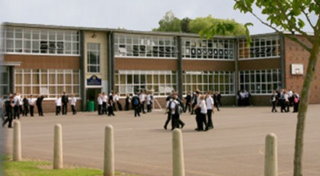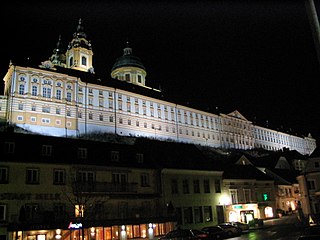
A college is an educational institution or a constituent part of one. A college may be a degree-awarding tertiary educational institution, a part of a collegiate or federal university, an institution offering vocational education, or a secondary school.

A primary school, junior school, elementary school or grade school is a school for primary education of children who are four to eleven years of age. It typically comes after preschool and before secondary school.

A school is an educational institution designed to provide learning spaces and learning environments for the teaching of students under the direction of teachers. Most countries have systems of formal education, which is sometimes compulsory. In these systems, students progress through a series of schools. The names for these schools vary by country but generally include primary school for young children and secondary school for teenagers who have completed primary education. An institution where higher education is taught, is commonly called a university college or university.

Secondary education covers two phases on the International Standard Classification of Education scale. Level 2 or lower secondary education is considered the second and final phase of basic education, and level 3 (upper) secondary education is the stage before tertiary education. Every country aims to provide basic education, but the systems and terminology remain unique to them. Secondary education typically takes place after six years of primary education and is followed by higher education, vocational education or employment. In most countries secondary education is compulsory, at least until the age of 16. Children typically enter the lower secondary phase around age 11. Compulsory education sometimes extends to age 19.

A student is primarily a person enrolled in a school or other educational institution and who is under learning with goals of acquiring knowledge, developing professions and achieving employment at desired field. In the broader sense, a student is anyone who applies themselves to the intensive intellectual engagement with some matter necessary to master it as part of some practical affair in which such mastery is basic or decisive.

A grammar school is one of several different types of school in the history of education in the United Kingdom and other English-speaking countries, originally a school teaching Latin, but more recently an academically oriented secondary school, differentiated in recent years from less academic secondary modern schools. The main difference is that a grammar school may select pupils based on academic achievement whereas a secondary modern may not.

A gymnasium is a type of school with a strong emphasis on academic learning, and providing advanced secondary education in some parts of Europe comparable to British grammar schools, sixth form colleges and US preparatory high schools. In its current meaning, it usually refers to secondary schools focused on preparing students to enter a university for advanced academic study. Before the 20th century, the system of gymnasiums was a widespread feature of educational systems throughout many European countries.
A middle school is an educational stage which exists in some countries, providing education between primary school and secondary school. The concept, regulation and classification of middle schools, as well as the ages covered, vary between, and sometimes within, countries.

Education in Canada is for the most part provided publicly, and is funded and overseen by provincial, territorial and local governments. Education is within provincial jurisdiction and the curriculum is overseen by the province. Education in Canada is generally divided into primary education, followed by secondary education and post-secondary. Within the provinces under the ministry of education, there are district school boards administering the educational programs.
State schools or public schools are generally primary or secondary schools that educate all children without charge. They are funded in whole or in part by taxation. State funded schools exist in virtually every country of the world, there are significant variations in their structure and educational programmes. State education generally encompasses primary and secondary education.
A secondary school describes an institution that provides secondary education and also usually includes the building where this takes place. Some secondary schools provide both lower secondary education and upper secondary education i.e. levels 2 and 3 of the ISCED scale, but these can also be provided in separate schools, as in the American middle and high school system. In the UK, elite public schools typically admit pupils between the ages of 13 and 18. UK state schools accommodate pupils between the ages of 11 to 18.
A comprehensive school is a public school for elementary aged or secondary aged children that does not select its intake on the basis of academic achievement or aptitude, in contrast to the selective school system where admission is restricted on the basis of selection criteria. The term is commonly used in relation to England and Wales, where comprehensive schools were introduced as state schools on an experimental basis in the 1940s and became more widespread from 1965. With the Blair educational reforms from 2003, they may be part of a local education authority or be a self governing academy or part of a multi-academy trust.
Ninth grade, freshman year, or grade 9 is the ninth year of school education in some school systems. Ninth grade is often the first school year of high school in the United States, or the last year of middle/junior high school. In some countries, Grade 9 is the second year of high school. Students are usually 14–15 years old. In the United States, it is often called Freshman year.
Twelfth grade, senior year, or grade 12 is the final year of secondary school in most of North America. In other regions, it may also be referred to as class 12 or Year 13. In most countries, students are usually the ages of 17 and 18 years old. Some countries have a thirteenth grade, while other countries do not have a 12th grade/year at all. Twelfth grade is typically the last year of high school.
Shane Niemi (born June 2, 1978 in Kamloops, British Columbia is a retired Canadian sprints athlete. As a 17 year old he took the bronze medal in the 400 metres at the 1995 Pan American Junior Athletics Championships behind Obea Moore's still standing World Youth Best. The same three athletes finished in the same order at the 1996 World Junior Championships in Athletics. He returned to the 1997 Pan American Junior Athletics Championships to take the gold medal in the event. He was not able to make the qualifying standard for the 2000 Olympics. He ran his personal record, the Canadian record, 44.86 at the 2001 Jeux de la Francophonie on home soil in Ottawa to take gold. He didn't have the same magic at the home field 2001 World Championships in Athletics but the following year took silver in a tight battle at the 2002 Commonwealth Games beating the world champion Avard Moncur. He won six straight Canadian championships between 1998 and 2003. Unable to make the qualifying mark to the 2004 Olympics, he retired in late 2004.
Educational stages are subdivisions of formal learning, typically covering early childhood education, primary education, secondary education and tertiary education. The United Nations Educational, Scientific and Cultural Organization (UNESCO) recognizes seven levels of education in its International Standard Classification of Education system. UNESCO's International Bureau of Education maintains a database of country-specific education systems and their stages.
The Higher Secondary Certificate (HSC/INTER/+2/ALIM) is a public examination used for university admissions in Bangladesh, India, Nepal and Pakistan. HSC is equivalent to GCE A Level in England and 3rd and 4th year of high Schools in United States.
High schools in North America are schools for secondary education, which may also involve intermediate education.








